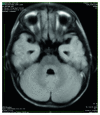Extrapontine Myelinolysis following Extreme Hypernatremia and Hyperosmolarity
- PMID: 30800484
- PMCID: PMC6360061
- DOI: 10.1155/2019/7381597
Extrapontine Myelinolysis following Extreme Hypernatremia and Hyperosmolarity
Abstract
We present a case of a nearly 3-year-old girl who was admitted to hospital due to severe hypernatremia (196 mmol/l). Her medical history included central hypothyreosis and growth hormone deficiency. Rehydration and normalization of sodium was achieved according to guidelines. On the fourth day of hospitalization, the patient developed tremor, ataxia, and rigor. Cranial magnetic resonance imaging (cMRI) was performed and (mis)interpreted for meningoencephalitis, with corresponding diagnostic and therapeutic implications. The patient had extrapontine myelinolysis. The child recovered completely after hospitalization for nearly 2 weeks.
Figures




References
-
- Nicolai T. 6.2.1 Hypernatriämische Dehydratation. 5th. 2014. Pädiatrische Notfall-und Intensivmedizin; pp. 154–158.
Publication types
LinkOut - more resources
Full Text Sources

